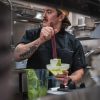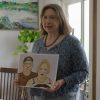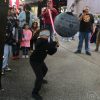InterView Chief Galen Carroll By: Chris Murphy
Public safety is so important in every city. Modesto has so many diverse groups, so many needs that spread our police department very thin. There are some tough spots and there are also some very bright spots where we are a positive example. Chief Galen Carroll accepted the challenge to take Modesto to the next level in safety, security and community teamwork. Trained in the streets of Long Beach, Chief Carroll has had to face many obstacles larger than those here. He has his BA and Masters Degrees and extensive training with the FBI. He and his wife are enjoying Modesto and we are looking forward to his vision as Modesto USA takes the steps to be a truly great city.
Since this is March and we are celebrating all things Irish, we introduce you to Modesto Police Chief Galen Carroll.
ModestoView: You have been on the job for just over a year, what are some of the biggest changes you have made to the department?
Chief Galen Carroll: I was blessed to take over a police department with a very solid base; there are a lot of very talented individuals in both the leadership ranks and the front lines of this department. The biggest changes we have worked on over the past year involved the use of technology, crime analysis and accountability for crime to make the most of our limited resources. Our department was rightfully a very proud department prior to the massive budget cuts in 2008 that led the way in policing up to that point. I found a department that still had a great deal of that pride, but seemed to be in “survivor mode” from losing 20% of its staffing and trying to figure out how to provide the same services with a lot less people. We brought back our crime analysts who spend their time looking for trends and intelligence in our crime reports, then create weekly reports that are used by our officers to focus our resources where they will be the most effective. We also invested in several software programs and can now create automatically-generated reports targeted to specific topics that are sent out to our staff. We also returned to area commands to bring accountability for crime back to the department. Each area is led by a lieutenant who is responsible for responding to crime spikes in their area and for developing tighter ties with the community. In addition to the added responsibility, the area commanders are allocated additional resources to make an impact in their area. We also invested in PredPol, a predictive policing software. The program takes 10 years of crime data, updates it daily and, using mathematical algorithms, develops a 500-square-foot box in the different area commands of our city where the highest probability of selected crimes will occur. This information is shared at each shift briefing and officers are then directed to spend their free time in and around those boxes instead of trying to randomly patrol an entire area or beat. We just rolled it out and it has been surprisingly accurate. There are some additional programs we just received which will allow us to more accurately determine our resource allocation based on calls for service and will help in the future as we continue to evaluate how we police the city. Finally, we have also begun to use our limited motor officers differently; instead of only working traffic complaints, they are now put into hotspots that include crime as well as accidents to impact our crime rates. Four to five motor officers in any given area generally crushes crime in that area just based on their visibility and the fact that criminals are usually driving around looking for opportunities to victimize our citizens.
MV: What do you enjoy most about your job? Least? GC: I am having fun, but I have always had fun at any job I have done. I enjoy the challenge of keeping the plates spinning; keeping a workforce happy; protecting the city with limited resources; dealing with constant budget issues; making dozens of decisions daily that may seem innocuous but are the most important decision to the people they impact. Modesto is no different than any other municipal government; differing political views; views on what is best for the future; what we need to do to prosper and routes to get there. It is fun to watch and see how decisions are made.
What I like the least would be the politics. I am a pretty straightforward person and although politics is something that starts on the playground in elementary school, I still find it distasteful.
MV: What would you describe as your management style as the chief?
GC: We often see ourselves in a different light than the people who work with us. My management style varies depending on the situation. I try to be participatory; however, I have been and can be very autocratic at times. I am a “people person” and I enjoy the people I get to work with, although I do not get to spend as much time getting to know each of them as well as I would like to. I am a big believer that you give people your expectations and then leave them alone. I shouldn’t have to tell someone to do their job or even how to do their job if I have given clear expectations of the final outcome. It’s funny. I don’t really like telling people what to do because I believe, if you applied for the job and you were hired, you should know what you should be doing, especially after we have provided training to you. I love selfless individuals who want to make the team succeed. I can’t stand laziness, excuses and poor customer services, both as a consumer and as a boss.
MV: Homelessness is an issue we face along with other cities, what needs to be done differently than we are doing now and what can people in Modesto do?
GC: Homelessness is a huge social issue that has so many facets. As a society, we will never solve this issue completely; however, I believe we can make an impact on homelessness in our city. Modesto is a very caring community; there are a ton of service groups, church groups and other entities that provide a great deal of charitable work in our city. That is the fabric of a community; however, in our case, our caring spirit, without forcing individuals to change their choice of lifestyle, has become a barrier to helping solve the problem. We have become enablers to those individuals with drug and alcohol problems. Rather than providing food or clothing while directing them towards help, we provide so many places to eat and get clothing each day that we are attracting the homeless from other cities. As an example, we had two individuals hitchhike to Modesto from Chico because they heard about everything we provide here. When an individual has alienated their own family through drug and alcohol abuse to the point they are on the street, we step in and make it reasonably easy for them to continue their destructive behavior. Food is delivered to the parks they choose to live in. They can walk a few blocks and panhandle for cash to buy drugs or alcohol, then go back to park, get drunk or high, wait for the next food delivery, and repeat the cycle throughout the week. There are empty beds at the Rescue Mission and Salvation Army most of the time because these individuals don’t want to follow any rules or give up their drugs and/or alcohol.
If we want to truly make a change, all of our service providers and church groups need to get on the same page, develop one location where the food and clothing is provided along with the services necessary to get them off drugs and alcohol. Right now there are so many people providing food and clothing that it is often dumped in piles at the parks after the groups leave. Plain and simple, for any person to change, including homeless, the change has to be less painful than their current state. If that isn’t the case they will continue on their current path. I have been meeting with different service providers with the help of Kevin Carroll at the Rescue Mission to try and work together towards this goal; however, everyday a new group joins in on their quest to provide food and clothing to the homeless without first finding out what is already out there and how they might better spend their time and resources.
What can the people of Modesto do? Just say “No.” Stop giving to panhandlers for a start. If they feel the need to give, save it for a provider that is going to offer drug and alcohol treatment and a way off the street. I am considering placing large signs at those intersections most frequented by panhandlers. The signs would display a phone number where the panhandler can get services. That way, if a person gets approached for money or food, they could kindly point to the sign in an effort to help the person.
We also need to work with the County to address the mental health issues of the homeless population. We need to figure out how those individuals ended up on the street. If someone is collecting their SSI checks, where they are supposed to be living, and why are they collecting money for caring for the mentally ill and not being held accountable? As you can see, there are many complexities to this social issue.
MV: How important having housing downtown in regards to increased public safety?
GC: There are many aspects to increasing public safety. Housing in the downtown area would help, depending on the type of housing. When I think of cities with the most vibrant downtowns, there is nice mix of medium to higher scale housing, office space, restaurants and night life. They usually provide transportation alternatives that tend to draw more people downtown because it creates its own energy. Currently, we are lacking those elements in our downtown, but the bigger question is, “Is there a market for it in Modesto?” Historically, we have been an agriculture region/town. We don’t currently have a transportation hub (aka ACE train), or some of the other features such as major commercial centers downtown that would draw professionals or young college students to other vibrant downtowns. I think one of the issues facing Modesto is defining what we are currently and what we as a city want to be in the future?
MV: Live music is a big part of Modesto’s culture. How do we safely create excitement, encourage live music and creative vibrancy in downtown Modesto and does this require a special kind of “ambassadorial” policing?
GC: When I think of nice downtowns filled with live music, local talent, etc., I think of places like the Gaslamp in San Diego, Downtown San Luis Obispo, Pine Avenue in Long Beach, and numerous other cities and locations. One thing all of those places have in common is a mix of venues where people can walk and enjoy themselves. Very few have the large night clubs of the late 1990s and early 2000s. Most of those clubs have transformed into different types of venues.
I believe we need to work together to define what we want downtown Modesto’s nightlife to be. What is the demographic we want to attract? And we need to develop a brand for the area. Music and classic cars define Modesto, and how many car shows do we have downtown? How many car-themed or rock-and-roll-themed venues do we have? Why don’t we pick a street that is pedestrian friendly, put a replica arch over it with a tribute to Graffiti Night or even the City arch and have that be the entrance to our “Entertainment District?” There are a lot of great ideas that I know Josh Bridegroom and others are working on to define downtown. Chris, one of your ideas was local artists playing music on the sidewalk. I think that’s a good idea as long as it is planned right so, as a police department, we don’t have a downtown filled with panhandlers playing a two string guitar screaming next to restaurants asking for money.
The big elephant in the room is how the MPD polices downtown. The downtown has changed a great deal over the past several years, from large nightclubs with large rowdy crowds to many empty clubs and restaurants. My goal in the future would be to have bicycle officers assigned to the downtown area who would be ambassadors to all the businesses. It would be their job to know the problems, issues and people. We have not gotten there yet. Part of the issue with downtown is, when I look at hotspots for crime and calls for service, the downtown is always the largest hotspot, so we need to figure out how to address those issues while being business friendly. Another issue that has occurred downtown in the past is that some bar owners believed they were only partially responsible for over-serving patrons inside their establishment and not responsible for what they did when they left. If we truly want a thriving downtown it will take a team effort where bar owners are not only responsible for not over-serving people but also care more about what happens in the area around their establishment rather than just pushing the problem out to the street and expecting the police to deal with it.
MV: What would you say to a young person considering a career in police work?
GC: It is the greatest job in the world! Don’t come into the job expecting people to appreciate anything you do. Expect to have people watch and judge everything you do even when you’re off duty. Expect to make a difference in someone’s life and enjoy the ride.
MV: It is always a challenge to staff the police in any city at the levels that are needed, what can the community do to make our public safety resources go farther?
GC: Staffing is a challenge especially here in the Central Valley. The community can really work to get to know your neighbors, become friends with them, have neighborhood gatherings and don’t be afraid to show someone who doesn’t belong in your neighborhood that they are being watched. I can’t give a lot of details, but we were following a suspect who we were pretty sure was doing burglaries in our city. Every time he got out of his car one day, we were following him. He was scared off by neighbors who stood across the street on their phones or asked him if he was lost. Public safety is all of our responsibility. The tighter we are as a community, the safer we will be.
MV: If you have unlimited funds, what one thing would you do differently?
GC: The easiest answer is I’d hire another 60 cops. We could do some great things with the additional staffing, but, since you said unlimited, I would create a vaccine that parents could give their children while they are young that would inoculate them against meth and heroin which are destroying our families and communities.
11. What is your favorite sport / recreation and did you play sports growing up?
My favorite sport is football by far. I have been a Raiders fan since I was 8. Growing up, we did not have a television and football was the only game that I could listen to on the radio every week. I grew up playing football as well, playing Pop Warner from age 8 through high school.
MV: Beatles or Stones?
GC: Metallica???? Growing up in the 80s with heavy metal bands you would think I would sway more towards the Stones, however, I think overall, the Beatles had more influence in today’s music.









